This is the story of British-funded ‘ambulance’ trains, in use on the Continent during the ‘European War’, as first published in The Railway Magazine in September and October 1915.

In later issues of the RAILWAY MAGAZINE during 1914 particulars were given of the numerous “hospital” or “ambulance” trains placed in service on the home railways, in order to meet one of the special demands created by the European War in which we are concerned. In May, 1915, further ambulance trains were described, these being intended for service nearer to the immediate war area, and now we are able to deal with other trains for service on the Continent which have been and are being equipped at the works of several of the British railway companies.
Early in the war several ambulance trains were equipped for service on the French railways. Then came three trains supplied from this country, of which the cost of two was largely defrayed by the United Kingdom Flour Millers Association. A fourth is known as the Queen Mary train, or as the “Lord Michelham” train, that nobleman having been largely associated therewith. There is also the Princess Christian Hospital Train, equipped in conjunction with the Red Cross Society, of which Her Royal Highness is President. These trains were described in the RAILWAY MAGAZINE for May, 1915. Four were built at railway companies works here, largely utilising existing rolling stock suitable for adaptation; the Princess Christian train was specially built by the Birmingham Railway Carriage and Wagon Co., Ltd.
All these trains have rendered good service and are regularly in use; but with the growing demands of the war area additions are called for, and eight others, each consisting of 16 vehicles, are being supplied by various home railways. It is with these that we are now principally concerned, and the matter is of further interest in that some of them have been utilised for public exhibition, with a view to raising funds for the benefit of wounded soldiers, and especially the supply of comforts, etc., to those who have come from the railway service. A start was made by the Lancashire and Yorkshire Railway Company, their train being exhibited on July 9th at Exchange station, Liverpool,. between the hours of 12 noon and 6 p.m. A charge of 1s. was made, the money collected being used for providing comforts for the soldiers and sailors at the auxiliary military hospitals in Liverpool. Nearly 5,000 people passed through the train during the hours noted, realising a sum of about 300.
The station platform was attractively decorated with bunting and flags, and there were in attendance thirty-two members of the Lancashire and Yorkshire Railway Centre of the St. John Ambulance Association in the Liverpool district, and a number were in the uniform of the St. John’s Brigade. Several nurses also lent assistance in the pharmacy and staff cars. The Lady Mayoress (Mrs. J. E. Rayner), in the absence of the Lord Mayor, who was detained at an important meeting, opened the inspection. There were also present during the day: Sir George Armytage (Chairman of the Company) and Lady Armytage, Mr. Aspinall (General Manager) and Mrs. Aspinall, Sir George Pilkington (Director), Sir James and Lady Barr, Col. Gemmell, Major Darwin, and many leading citizens of Liverpool. Mr. F. E. Gobey (Assistant Carriage and Wagon Superintendent, to Mr. G. Hughes, Chief Mechanical Engineer), under whose supervision the train has been constructed, and Mr. G. H. Nutter (Secretary of the Lancashire and Yorkshire Railway Ambulance Centre) were in attendance throughout the day and had charge of the arrangements.


We may here mention that ambulance men in the service of the Lancashire and Yorkshire Railway at the Liverpool station and depots have attended all the ambulance trains arriving at Aintree since the commencement of the war, assisting in the transfer of 8,700 wounded soldiers to the hospitals, and the military authorities have on several occasions expressed their appreciation of the great service rendered by the railwaymen.
Partly in consequence of the conspicuous success realised by the exhibition in Liverpool, the London and North Western Railway arranged for the exhibition at Euston of the more interesting vehicles of -one of the trains equipped at Wolverton Carriage Works, under the direction of Mr. H. D. Earl, Carriage and Wagon Superintendent. These were placed at No. 12 platform on Wednesday, July 21st, and open for inspection between 8.0 a.m. and 6.30 p.m. A charge of 1s. was made for each person inspecting the vehicles, the money collected being devoted to the fund for providing comforts for the Railway Troops (R.E.) serving with the Expeditionary Force.
A portion of No. 12 platform was partitioned off alongside the train and provided with an entrance gate and ticket office at one end, and an exit gate, where tickets were collected, at the further end. Several representatives of the Company were in attendance, going through the train with various parties. So great was the interest evinced that the exhibition was continued on the following day, with equally satisfactory results.
On Wednesday a party of high officers from the War Office attended at an early hour, and Mr. Guy Calthrop (General Manager), Mr. L. W. Home (Superintendent of the Line ), Mr. E. F. C. Trench (Chief Engineer), and, in fact, virtually all chief and many other officers of the London and North Western Railway went through the train during the morning. Numerous officials from other railways also came along, and there were many people of note, both in public and private life. Several parties of nurses from London hospitals were among the visitors, and on Thursday afternoon about 500 non-commissioned officers and men of the 2nd Division, London District, R.A.M.C. (T.) were given facilities for inspecting the train.
Ladies constituted a considerable proportion of the visitors, and a notable feature of the days proceedings was the number of suburban residents who had plainly come to town for the purpose, or had combined a visit to Euston with other engagements. Besides the sums realised by the charge of 1s., collecting boxes were well supported, while the collecting dog “Brum” was not behindhand in soliciting contributions in his own way, his record being about £6 6s. (mainly in coppers) on the first day, while with another dog now in training a further sum of over £2 was added on the second day. Altogether, a sum of over £323 was realised by the exhibition, and about 6,000 people passed through the train.
The same train was then shown at Cannon Street station, South Eastern and Chatham Railway, on Tuesday, July 27th. A charge of 1s. was again made for each person inspecting the train, the money collected being given to the fund for providing comforts for the Railway Troops (R.E.) serving with the Expeditionary Force. The total number of persons who inspected the train was 3,968, and a sum of £212 8s. (£14 of which was collected by a dog) was realised. The Lord Mayor of London was amongst the visitors.
By the courtesy of officials of the Lancashire and Yorkshire and London and North Western Railways we are able to illustrate and describe these trains, which differ in several respects from ambulance trains previously dealt with in the RAILWAY MAGAZINE.
The Lancashire and Yorkshire Railway train constructed at the carriage works, Newton Heath, consists of 16 bogie carriages, with a total length of 939 ft. 7 in. over buffers, and weighing when loaded 492 tons. The vehicles were withdrawn from ordinary traffic, and are of the modern elliptical roof design now standard on the Lancashire and Yorkshire Railway, being equipped in accordance with arrangements made through the Ambulance Trains for the Continent Sub-Committee of the Railway Executive Committee. The formation and accommodation of the train are: 1 brake van with stores (with accommodation for train guard), 1 kitchen car (3 cooks), 4 ward cars with cots for 144 lying-down cases, 1 pharmacy car with pharmacy, treatment room, office, and stores, 1 staff car (for medical officers and nurses), 4 ward cars for sitting-up cases (256 patients), 1 ward car for sitting-up cases (infectious, 64 patients), 1 kitchen car (3 cooks), 1 personnel car (32 persons), 1 brake Van with 2 infectious wards and cots for 18 infectious lying-down cases; total 16 cars, with accommodation for 530 persons.
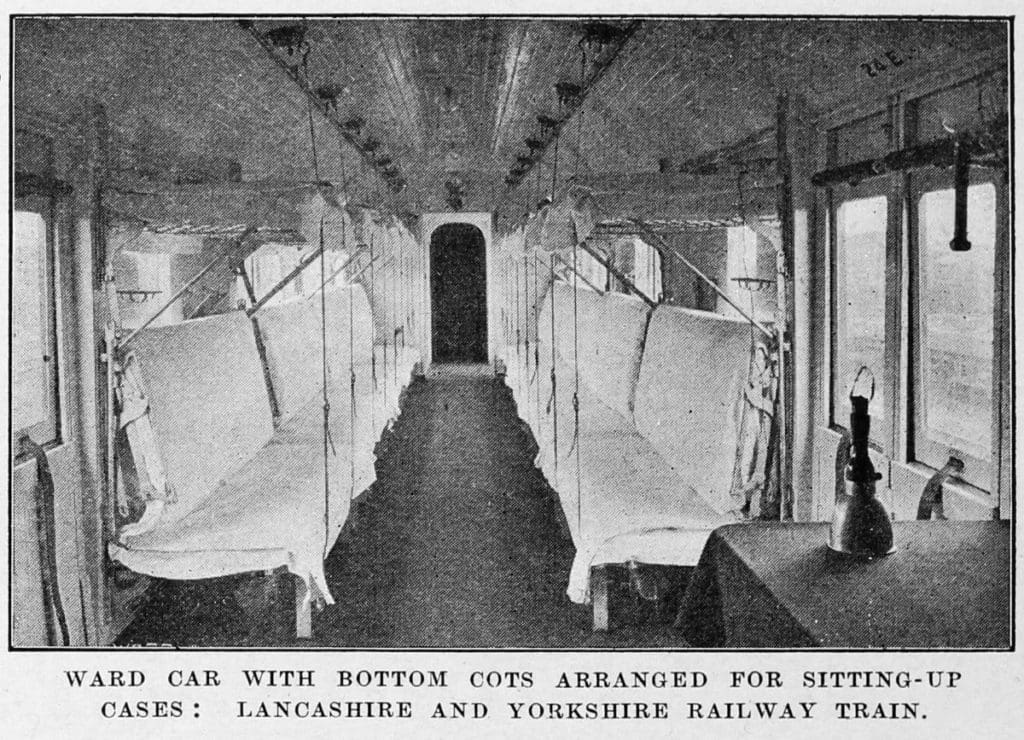
Vestibuled throughout, the train is fitted with electric light and fans, some of the latter in each ward being of portable type to fix upon any cot for cases calling for special treatment. The ward cars are enamelled throughout in white; the cots are in three tiers, and can be placed against the sides when not in use. The middle berth can also be lowered to form a back for sitting-up cases when required. The kitchens are fitted with standard Army ranges, supplied by the London Warming and Ventilating Co., Ltd., coupled to a hot water installation, providing a constant supply of 50 gals. of hot water in each kitchen. The water supply on the train is a very important matter, and ample storage is carried on each car, the total for the whole train being about 2,000 gallons.
The staff car is provided with messroom for the medical officers and nurses, and berths arranged so that they are convertible for day or night use; this also applies to the personnel car, and both of these vehicles can either be heated by steam from a locomotive or independently from a stove and hot water system according to the circumstances. The exterior is painted khaki with a Red Cross in the centre of each vehicle. Westinghouse automatic air brakes of the standard pattern are fitted throughout, and all the coupling-up arrangements have been made suitable for connecting to Continental locomotives.
This ambulance train provides much greater accommodation than those in use in Great Britain perhaps one of the chief features is that every advantage has been taken in utilising the space for the comfort of the sick and wounded under all their many varying conditions, and also for the convenience and requirements of the medical officers, nurses, and personnel.
In the case of the London and North Western trains, the vehicles on view at Euston and Cannon Street included four ward cars, each containing 36 cots for lying down cases; one pharmacy car, containing all necessary accommodation for medical appliances, and also a treatment room equipped with operating table, etc; one staff car, with accommodation for medical officers and nurses; one personnel car, to accommodate orderlies, day and night (to sleep 28); two kitchen cars, with suitable accommodation for cooks, accommodation for stores, special stores, mess room, etc.; and one brake van, with separate wards for infectious cases. These 10 vehicles belong to one of the two ambulance trains just finished at Wolverton, and consisting each of 16 coaches. The remaining vehicles are of more usual classes, hence their omission, seeing that the platform was fully occupied with the rolling stock included.
All cars used by the staff and personnel are fitted with a special self-heating equipment, so that they are independent of the engine as regards internal heating. Drinking water tanks are provided as required, with padlock control for filling and drawing off. Throughout the train special candle brackets are fitted, for use when electric light is not available from the dynamo-driven electric carriage lighting equipment, though there is a good battery reserve.
Lighting is on Stone’s system, in view of its suitability for service on coaches working to no fixed timetable and subject to long periods of standing and slow running. To meet the exceptional requirements of the case, use has been made of special dynamos which are capable of generating current at a speed of but little more than 10 miles an hour. These machines are of the latest type, and fitted with ball bearings. The supply is at 24 volts. The whole of the apparatus is of British manufacture.
Double doors are provided to all lying down patients cars, so that stretcher cases can easily be dealt with, and there are numerous windows, so that plenty of fresh air can be obtained as desired. Internal walls of open coaches, corridors, cooking and store compartments, mess rooms, etc., are all painted with white enamel, and designed so that there are no corners where dust may accumulate. Bedsteads are of folding type attached to the walls, and equipped with mattresses, etc, as usual. They have been specially designed to meet the exceptional requirements.


One car had the beds prepared for use, another showed them without the complete equipment, a third had the top tier folded up out of the way, while the lower ones were arranged to form comfortable couches for sitting-up cases. The fourth car had the bedsteads all folded up out of the way as for cleaning and washing out the cars. Heaters under each tier of cots are independently controllable, so that it is not necessary to heat the whole of a car to the same degree. Electric fans are provided in the cars, and a special feature is that besides fixed ventilating fans at each end and a punkah fan in the centre of each car, there are portable fans, supplied by flexible wall plug connections, so that a draught can be caused to play upon the face of any patient who requires it.
One of the end car Vehicles includes two wards, each complete in itself, for infectious cases, one for 12 patients and the other for six, thus enabling infectious cases of different kinds to be separated. The remainder of the car is divided off by an airtight partition, and accommodates the guard, who has a living compartment in addition to that used for train control. The personnel car is in compartments, each adapted for two berths on each side, the upper ones folding down to form backs to the lower ones for day use. Portable tables can be fitted as desired. In place of the usual racks, shelves are fitted near the roof.
The kitchen and mess room car includes accommodation for field officers’ kits, longitudinally arranged mess room, cooks room (with three beds), and a large kitchen fitted with Army Service range supplied by the London Warming & Ventilating Co., Ltd., refrigerator and crockery racks, etc. The stove is designed to ensure a supply of 50 gals. of hot water at all times, or large quantities of hot soup, etc. The staff car is reserved at one end for doctors and at the other for nurses. At the doctors’ end the mess room has chairs on one side, and a seat on the other (this can be converted into a bed if desired), these facing a table for meals, while other arrangements have a bed on one side and a seat on the other, arrangements being made so that tables can be erected as required. The nurses are similarly provided for, except that there are two beds in each compartment and their mess room is entirely enclosed.
The pharmacy car includes medical comforts store, office for officer commanding (with safe, writing desk, etc.), treatment room (zinc-lined, with full-width sliding door, operating table, sterilising appliances, etc.), dispensary (also fully equipped), and linen store. The second kitchen car includes cooks compartment (three beds), stewards store and pack store. The brake and stores car (not shown) has accommodation for the guard, with a living room adjacent, the remaining space being utilised for stores. All vehicles are painted khaki colour, with large red crosses on the sides of each.
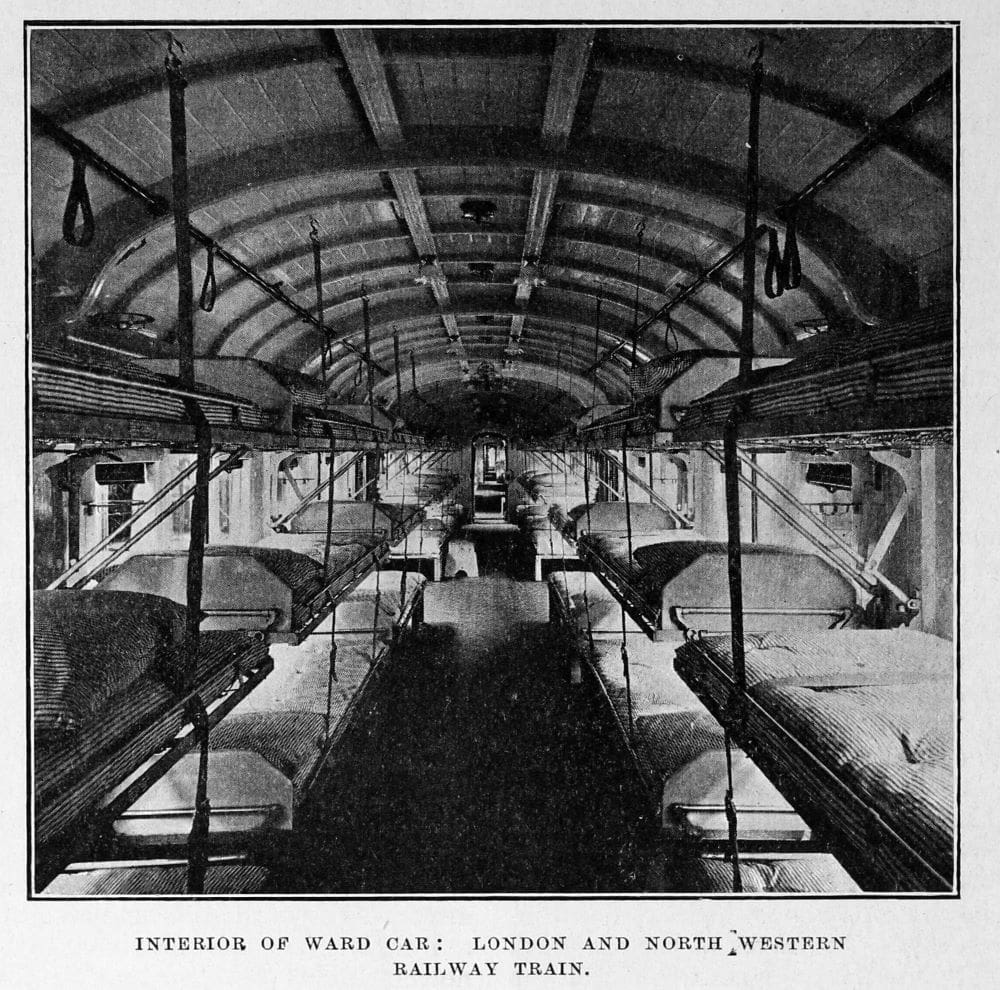
One of the ambulance trains recently constructed at the Great Eastern Railway’s Stratford Works, for the use of the Army in France, was on view at Liverpool Street station, platform No. 1, from 7.30 a.m. to 4.15 p.m. on Thursday and Friday, August 5th and 6th. Tickets, at 6d. each, were sold at the west side suburban booking office. Afterwards it was on view at various stations on the Great Eastern system and no fewer than 50,354 people inspected it. The total receipts, including sums received from collecting-boxes, amounted to £1,311 Os. 7d. The total amount is to be given to the fund for providing comforts for the railway engineering section serving with the Army in France.
The vehicles on view were as follows: Four ward cars for lying-down cases, each containing thirty-six cots; one pharmacy car containing all necessary accommodation for medical appliances, and also treatment room equipped with operating table, etc.; one staff car, with accommodation for medical officers and nurses, for night and day; for twenty eight; two kitchen cars, with suitable accommodation for cooks, etc., messroom, accommodation for stores, etc.; and one brake van, with separate wards for infectious cases. The total train consists of sixteen vehicles, including, in addition to the above, five cars for sitting-up cases, and one brake van (with section for stores).
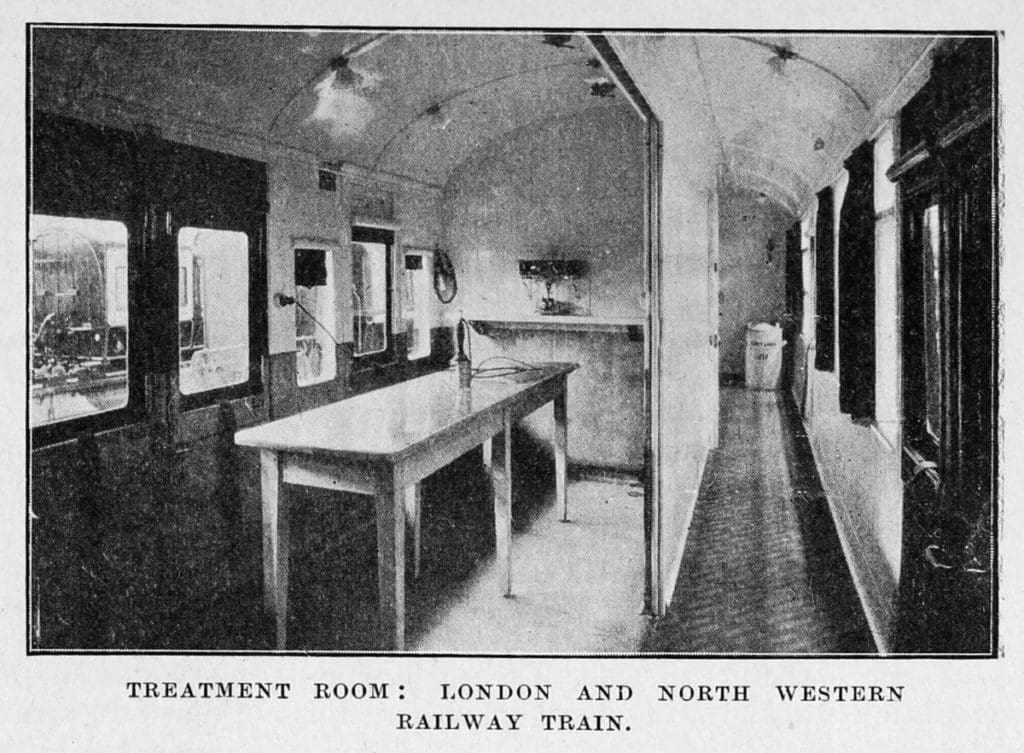

By selecting No. 1 platform it became possible to include the complete train of sixteen coaches, in the tunnel by which communication was maintained with the Metropolitan Railway. Vehicles in the tunnel were, of course, illuminated. The selection of No. 1 platform was further convenient in that there are double staircases, and one could be used for admission and one for exit, a necessary separation in view of the continuous streams of visitors to be dealt with. People passed on to the platform by one staircase, and then had to walk the whole length alongside the train to the front end, entering it there and returning through the coaches to the extreme rear, whence they returned as far as the exit stairway. One of the windows of the west side booking office was devoted entirely to the issue of ambulance train tickets, and these were checked at the entrance to the platform and collected as visitors passed into the train.
The complete train of sixteen vehicles is 864 ft. in length, made up of 54 ft. cars, and weighs about 448 tons. There is accommodation for 162 lying-down cases and for 280 sitting-up patients. Water supply amounting to about 2,000 gals. is provided, nearly every car having a drinking water tank, the taps having, however, padlock control, as is found desirable where invalids under doctors direction are concerned.
Seeing that it is made up from similar vehicles, this train includes many features corresponding to the train equipped at Stratford for the United Kingdom Flour Millers Association described some time ago; but there are also a number of differences. Special sanitary arrangements are included; also a hot water heating system, so as to be independent of the locomotive for steam heating as regards the staff and personnel cars. Other vehicles have Westinghouse steam heating equipment. The cots are also somewhat differently designed, and candle brackets are provided throughout the train so that complete dependence is not had upon the electric lighting equipment, though this, as is the case of other trains which have been described, has extra storage capacity. The system of electric lighting is Stone’s, specially designed to suit the circumstances under which these trains will work. One of the five compartment patients cars is intended for infectious sitting up cases, in addition to the two ward compartments with cots for more serious cases in one of the end cars. As showing the complete “stores” equipment, the end stores car has a zinc-lined section with meat hooks for suspending meat supplies, in addition to racks and cupboards for other stores. In the staff and personnel cars the beds are provided in the form of upper and lower berths, adapted for conversion into seats, the upper berths forming backs for the lower ones when folded down. Similarly the cots in the ward cars can be converted into comfortable seats, the frames of the upper tiers being turned up out of the way. There are sixty-nine electric fans in the train, a few being portable. One of the staff lavatories is equipped with a shower bath.
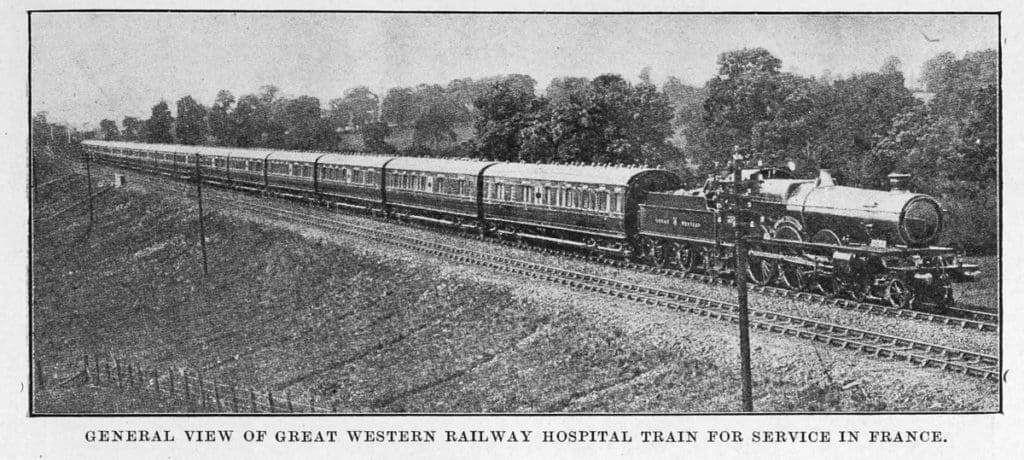
As a result of the Ambulance Train exhibition at Liverpool Street, upwards of 14,000 people passed through the train on the two days; and so great was the interest taken that arrangements were made for its exhibition during the following week at various places on the Great Eastern Railway system. On Saturday, Aug. 7th, it was shown at Norwich; on the Sunday, at Yarmouth in the morning and at Lowestoft in the afternoon. The following day it was on view at Cambridge, on Tuesday, Aug. 10th at Ipswich, and on Wednesday at Southend. On Thursday it was shown at Witham (7.30 a.m. to 10.45 a.m.); Clacton-on-Sea (1.0 p.m. to 4.15 p.m.); and Colchester (5.45 p.m. to 9.0 p.m.). The next day it was at Bury St. Edmunds (8.45 a.m. to 10.15 a.m.), March (12.45 p.m. to 3.30 p.m.) and Kings Lynn (5.0 p.m. to 8.0 p.m.). On Saturday, Aug. 14th it was on View at Hunstanton from 7.0 a.m. to 12 noon, and then came back to London, stopping at Bishop’s Stortford from 4.15 p.m. to 8.0 p.m., ready for a further exhibition at Liverpool Street station, in response to numerous requests, on Sunday, Aug. 15th (8.0 a.m. to 8.0 p.m.) and Monday, Aug. 16th (7.30 a.m. to 4.15 p.m.). Most of the country exhibitions drew from 2,000 to 3,000 visitors per day, while the second exhibition in London realised further notable results. It is stated that while at Liverpool Street station the train was visited by 27,000 men, and as before remarked, the number of people throughout the Great Eastern Railway system who paid to inspect the train totalled no fewer than 50,354.
A BOOKLET entitled Hospital Trains: How they are saving Soldiers Lives” has been issued by the “British Red Cross Society and the Order of St. John of Jerusalem in England.” Copies can be had on application to the Headquarters Collections Committee (Room 99), 83, Pall Mall, London, S.W., but some reference to its contents will be in order.
Naturally it is concerned mainly with trains equipped by or in conjunction with Red Cross agencies, as distinct from those trains which have been prepared on the instructions of the War Office and the Admiralty, and this fact must be borne in mind. In introduction it is pointed out that it was not until the Boer War that this country really appreciated the necessity for Hospital Trains and realised their value. While France, Russia, Italy, and other countries already possessed Red Cross trains, we had naturally concerned ourselves more with Red Cross ships. It is interesting to recall that in that war, as in this, the necessary funds for the first Red Cross Hospital Train were raised largely through the energy of H.R.H. Princess Christian.
The experience in construction gained fifteen years ago has been turned to good account to-day. Whereas, however, the old train was about 250 ft. long and accommodated 74 patients, its modern successor has a total length of 700 ft. nearly one-seventh of a mile and can accommodate as many as 450 patients. This splendid train was constructed by the Birmingham Railway Carriage Company, under the personal direction of Sir John Furley, with the practical assistance of Mr. William J. Fieldhouse. It was described in the RAILWAY MAGAZINE for May, 1915. The task with which designers and builders found themselves confronted was not an easy one in any case, nor were the difficulties diminished by the necessity for consulting different bodies on both sides of the Channel. While the French railway engineers asked that all couplings, brakes, and lighting arrangements should be submitted for their approval, the British War Office asked that four more coaches, each to carry 50 sitting-up patients, should be added to the eight originally contemplated. In addition, the French regulations required that an ordinary brake van should be attached to each end of the train. This brought up the number of coaches to 14.
In order to co-ordinate requirements, a Joint Committee was therefore formed, comprising the French railway engineers and also the managers of the leading English railway companies. Admittedly it had the great advantage of being designed and constructed from first to last solely in view of the purpose to which it was to be put.
As already indicated, the trains which have been equipped under Red Cross auspices must be considered on their own basis. There are, in fact, five different classes of ambulance equipment, apart from variations, to be taken into account, and they may be approximately classified thus: (1) the trains originally equipped in France; (2) the British trains for use on the home railways; (3) Red Cross and kindred trains built here by private generosity or on the basis of funds supplied by the public; (4) ambulance trains for service in France built here on the instructions of the Government; and (5) miscellaneous vehicles, such as the Glasgow, and South Western-built ambulance vans, and the North Eastern-built rest vans.
The first class covers a wide range, from hurriedly equipped trains prepared in France to at least one train made up of vehicles taken from English trains, and replaced for home use. Quoting again from the booklet referred to it is stated that the first of the Societies Hospital Trains to start its beneficent operations was the one known as “Number XI. Ambulance Train.” This was made up of third-class carriages belonging to a French railway company, equipped with fittings sent over from England and arranged on the spot at emergency speed. The train was very much handicapped by the circumstance that there was no through communication from coach to coach, and it was not possible to make one. Consequently, its management had to be left to the goodwill and ability of the staff. Each carriage was as far as possible self-contained if there were very serious cases in certain carriages, the staff had to be increased in that particular vehicle. Yet, notwithstanding every difficulty and contrary to all predictions, the train has proved a very great success, for which signal credit is due to commandant and staff.
As regards the trains equipped for service on the home railways, these received attention in these pages during the later months of 1914, as also the ambulance vans one of these, provided by the Glasgow and South Western Railway, was described last month and the “rest vans” prepared by the North Eastern Railway. But the third and fourth trains require differentiation. In the former class are the trains presented on the basis of private generosity or public subscription the more recent Red Cross trains proper. These include the “Princess Christian” train, the “Queen Mary” or “Lord Michelham” train and the two British sections presented by the United Kingdom Flour Millers Association. These four trains were described last May.
Then come the eight trains which are now receiving attention, and which are being utilised also for public exhibition for the benefit of benevolent and charitable funds. Last month the trains equipped by the London and North Western, Lancashire and Yorkshire, and Great Eastern Railways, for service in France, were described.
These trains are all designed on substantially the same lines, each consisting of 16 bogie vehicles equipped to give the same accommodation. Two were supplied. by the London and North Western Railway, two by the Great Western Railway, one by the Lancashire and Yorkshire Railway, one by the Great Eastern Railway, one by the Caledonian Railway, and one by the London, Brighton, and South Coast Railway.
On Wednesday, Thursday, and Friday, August 25th, 26th and 27th, the Great Western Railway exhibited one of the two ambulance trains equipped at Swindon for service on the Continent. The train was placed at platform A, the recently constructed extension of No. 1 main line departure platform. As this platform is generally utilised for excursion, milk and other special traffic, and has, besides, a separate entrance away from the main station, this location was particularly suitable for exhibiting the train, its length being sufficient to take the complete set of 16 vehicles.
A charge of 1s. for each person was made, the money collected, including that realised by the sale of packets of postcards illustrating the train and some of its vehicles, and by collecting boxes, being given to War Funds for the benefit of the wounded and for railwaymen serving in His Majesty’s forces.
There was not the crowded attendance which some other exhibitions have realised, but throughout the period during which the train was on view – 11 a.m to 7 p.m. each day there was a steady stream of visitors passing through. Several men from the Slough Division of the St. John Ambulance Association, together with a number of voluntary nurses from the same organisation, were in attendance along the train describing and exhibiting the various appliances available.
In general design the train corresponds with those equipped by the Lancashire and Yorkshire, London and North Western, and Great Eastern Companies, which have been already described, this being in accordance with instructions from the Sub-Committee appointed by the Railway Executive Committee for dealing with these trains. As, however, existing vehicles are utilised, there are necessarily certain variations, seeing that dimensions of vehicles differ somewhat, even for coaches of corresponding design, on different railways. In this case the large size of modern Great Western rolling stock has given slightly greater latitude in certain directions. This is particularly noticeable in the “personnel car”, the doctors’ dining saloon being quite a roomy compartment, with oval table placed longitudinally instead of transversely. The train is 960 ft, long and weighs 442 tons, the accommodation being the same as in other trains.
The Caledonian train has been exhibited during September in accordance with the following programme:
GLASGOW (CENTRAL) (Platform No. 1).- Thursday, September 2nd, 3 p.m. till 10 p.m.; Friday, September 3rd, 8 a.m. till 10 p.m.; Saturday, September 4th, 8 a.m. till 10 p.m.
EDINBURGH (PRINCES STREET) (Platform No. 1). Monday, September 6th, 3 p.m. till 10 p.m.; Tuesday, September 7th, 8 a.m. till 10 p.m.; Wednesday, September 8th, 8 a.m. till 10 p.m.
DUNDEE (WEST) (Platform No. 4). Friday, September 10th, 3 p.m. till 10 p.m.; Saturday, September 11th, 8 a.m. till 10 p.m.
ABERDEEN.- Monday, September 13th, 3 p.m. till 10 p.m.; Tuesday, September 14th, 8 a.m. till 10 p.m.
STIRLING (East Platform).- Wednesday, September 15th, 3 p.m. till 10 p.m.; Thursday, September 16th, 8 a.m. till 10 p.m.
PERTH (GENERAL) (Crieff Branch Dock). Friday, September 17th, 3 p.m. till 10 p.m.; Saturday, September 18th, 8 a.m. till 10 p.m.
GREENOCK (CENTRAL) (Up Dock). Monday, September 20th, 3 p.m. till 10 p.m.; Tuesday, September 21st, 8 a.m. till 9 p.m.
A charge of 1s. was made for each person inspecting the vehicles, the money collected going to the funds of the Scottish Branch of the Red Cross Society.
The Duchess of Montrose formally opened the Exhibition at Glasgow Central station on Thursday, September 2nd. Her Grace was introduced by Sir Charles Bine Renshaw, Chairman of the Company. Among those present were the Marchioness of Bute, Lord and Lady Newlands, Lady Stirling Maxwell, Sir Charles and Lady Bine Renshaw, Lady Patten MacDougall, the Lord Provost and Mrs. Dunlop, Sir George T. Beatson, Lieut. Col. R. D. M’Ewan.
The station was gaily decked with bunting, and it was early evident that Glasgow citizens were deeply interested in the train, and long before 3 p.m. hundreds of people had collected in the station. By the opening hour there must have been fully 2,000 who had provided themselves with tickets of admission, and this number was augmented continuously during the remainder of the afternoon. Just before the formal opening ceremony a draft of the 3/2nd Lowland Field Ambulance was inspected by the Duchess of Montrose.
This train has been equipped at the St. Rollox Works in Glasgow, under the supervision of the locomotive superintendent, Mr. William Pickersgill. It is made up of sixteen corridor carriages connected together by flexible gangways, and arranged in the following order:
1 brake and stores car (in front).
1 kitchen and stores car.
4 wards for lying down patients.
1 pharmacy car.
1 staff car.
5 wards for sitting-up patients.
1 kitchen and mess-room.
1 personnel car.
1 infectious ward and brake car (in rear).
The front car contains the guard’s brake, and living compartments, while the remainder of the space is set apart for comestibles and other stores. The two kitchen cars have each the usual culinary equipment, including an army service coke cooking and heating range, sinks, dressers, cupboards, tables, hot and cold water tanks, etc., also a cooks’ living room, with three folding cots. In the front kitchen car there is a stewards’ store, and a soldiers’ pack apartment, and the corresponding space in the other car is used as a mess-room, with folding tables, and as a store for officers’ kits. The walls of the kitchen proper are partially zinc-lined, and the floor is lead covered. An electrical fan helps to keep the cooking apartment cool.
The four ward cars for lying-down patients each accommodate thirty-six men in the cots, which are fixed lengthwise in three tiers at either side, and can be folded against the sides of car to facilitate cleaning or to permit of the lowest berths being used as seats. Stools are provided for reaching the higher cots. To facilitate loading, these cars are provided on both sides with double width doors for the easy admission of stretchers, and when considered desirable a patient may be deposited in a cot without withdrawing the stretcher. A constant current of fresh air is ensured by means of both fixed and portable electrical fans, the latter being available when required for playing direct on the faces of fevered or gassed patients.
Three of the five ward cars for sitting-up patients are constructed with saloon compartments, while two have side corridors and ordinary compartments, and afford seating accommodation for 292 patients. Four of the cars are upholstered in hygienic blue leather cloth, the remaining one having three-ply sycamore seats and backs, with the view of minimising the risk of infection in the case of doubtful cases. Fixed and portable electrical fans are also part of the equipment of these cars, which have a small pantry.
The pharmacy car has ample accommodation for dispensary commodities, and all necessary medicinal, surgical, and nursing appliances, including a water heater and a steriliser, as well as a treatment compartment with operating table. There is also an office for the doctors, containing a table, a chair and a safe, and several storage compartments for bandages, linen, splints, etc. The walls of the treatment compartment – as in the case of the kitchens – are partially zinc-lined, and the floor is 1ead covered. For the convenient handling of patients requiring special attention on the journey the corridor of this car has been made of sufficient width to readily admit a stretcher without discomfort to the patients. The treatment room is provided with a large sliding door.
The staff car gives accommodation for the medical officers and nurses. It has three state rooms for the officers, each containing a bed, a seat, and a folding table; and two state-rooms for the nurses, in each of which are two folding beds, a seat, and a folding table. At either end of the car are the mess-rooms for the doctors and the nurses, and in the doctors mess-room there is an emergency folding bed.
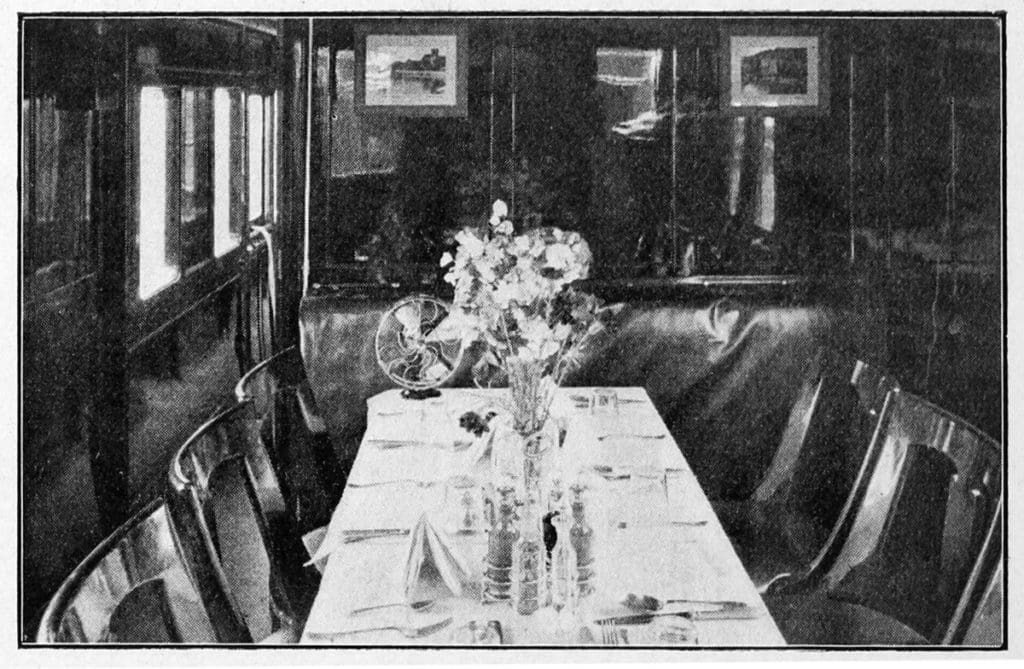
The personnel car consists of seven compartments with side corridor from end to end, and is for the use of twenty-eight orderlies. Each compartment has two beds – one placed directly above the other on either side – the top berth, when folded down during the day, forming a back to the lower one which is used as a seat. There are two shelves in each compartment for the use of the inmates. The rear car is the infectious ward, having two separate compartments with eighteen folding cots, and adjoining, but completely isolated from the infectious ward, is the guard’s brake and living compartments.
Throughout the train abundant sanitary and lavatory conveniences are provided, including drinking water, which, in the case of the ward cars, is contained in padlocked tanks, so that its use may be controlled. The total water tank capacity available for all purposes on the train amounts to 1,600 gallons.
Ventilation of the cars is effected by the usual roof air extractors, in addition to the electrical fans already referred to. They are also steam-heated, and in addition there is a self contained coke furnace installation in the staff and personnel cars. The lighting is by electricity generated by dynamo driven off one of the axles of each car, and in addition to this there are special candle brackets fitted throughout the train for use in cases of emergency. Floors are covered with thick inlaid linoleum.
The interiors of the vehicles generally are done up in white enamel, and the exteriors are painted khaki colour with a prominent Red Cross in the centre of each coach. Each car bears the train number on its sides and ends, together with a distinctive letter for identification. To ensure smooth and comfortable running, the springs are of the most approved description, and all the cars are carried on four-wheeled bogies. The brake installation is of the Westinghouse automatic air type, and all the coupling appliances are suitable for attachment to French locomotives. The train is 300 yds. in length, 442 tons in weight, and provides accommodation for 454 patients and forty-four officials, being a total of 489 persons.
Referring again to the “Red Cross” booklet it is there explained how these trains are staffed. The Officer Commanding usually bears the rank of Major of the Royal Army Medical Corps. He is responsible for the train and for all and everything on board, also for the loading and unloading of the train, the comfort of the wounded, and the control of the personnel in its multifarious duties. The Medical staff usually makes three, one of whom is appointed Chief Medical Officer. Each officer is responsible for the particular wards allotted to his care. The nursing staff comprises a Matron and a sufficient number of nurses or sisters, who may be placed in charge of one or more wards to assist the Medical Staff. Finally, there are the N.C.O.’s and Orderlies, the Cooks, the Dispenser and Storekeeper, and a Clerk.
It may be mentioned that the Joint Committee of the British Red Cross Society and the Order of St. John of Jerusalem is in close touch with the requirements of the War, wherever waged. It is working in harmony with the Military Authorities, and is only anxious to supplement the magnificent work done by the Royal Army Medical Corps. Everyone may feel that his money will go to the sick and wounded with a minimum of deduction for expenses. The administrative staff, which is large, is also mainly voluntary both in England and at Boulogne (the headquarters of the Committee in France), Malta, and Alexandria, and every possible precaution has been taken to secure the most economical administration of the funds entrusted to them by the public.

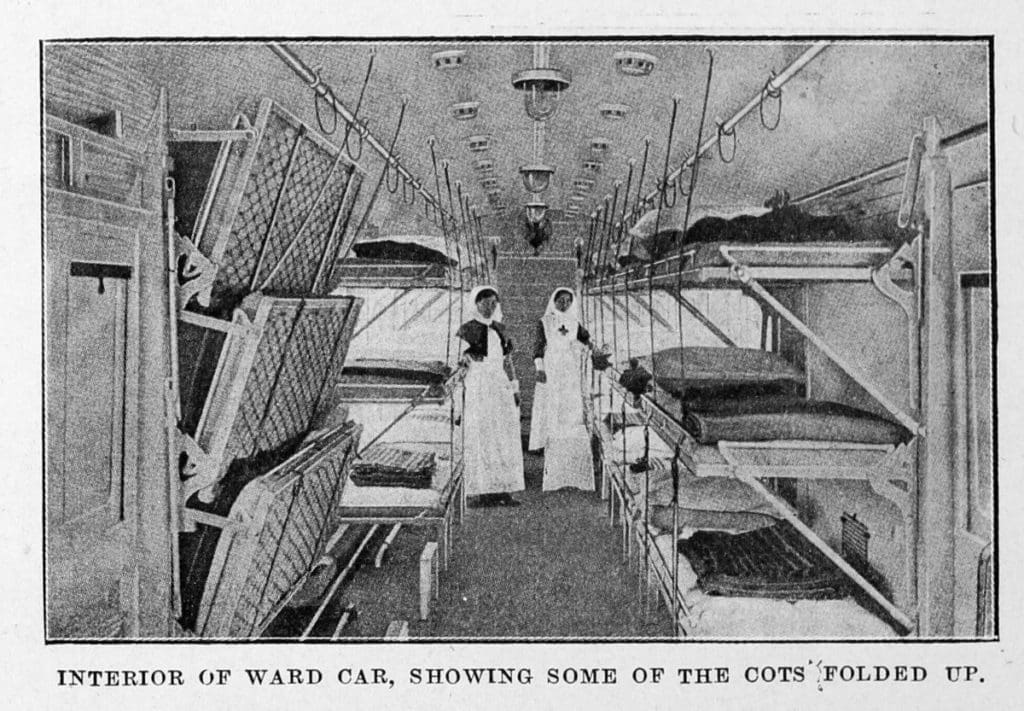

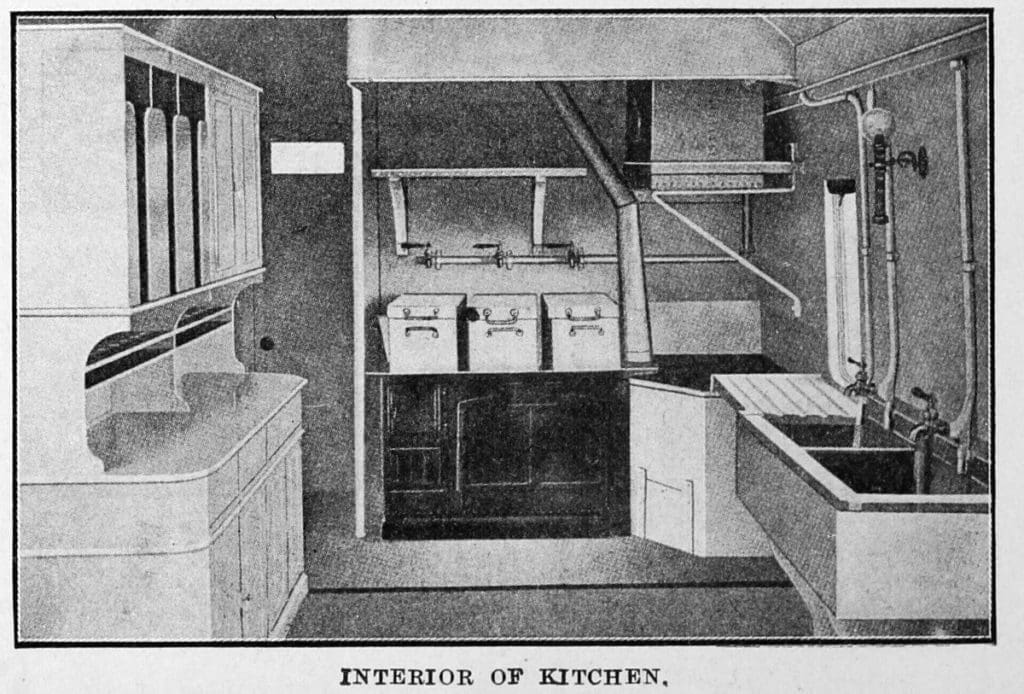
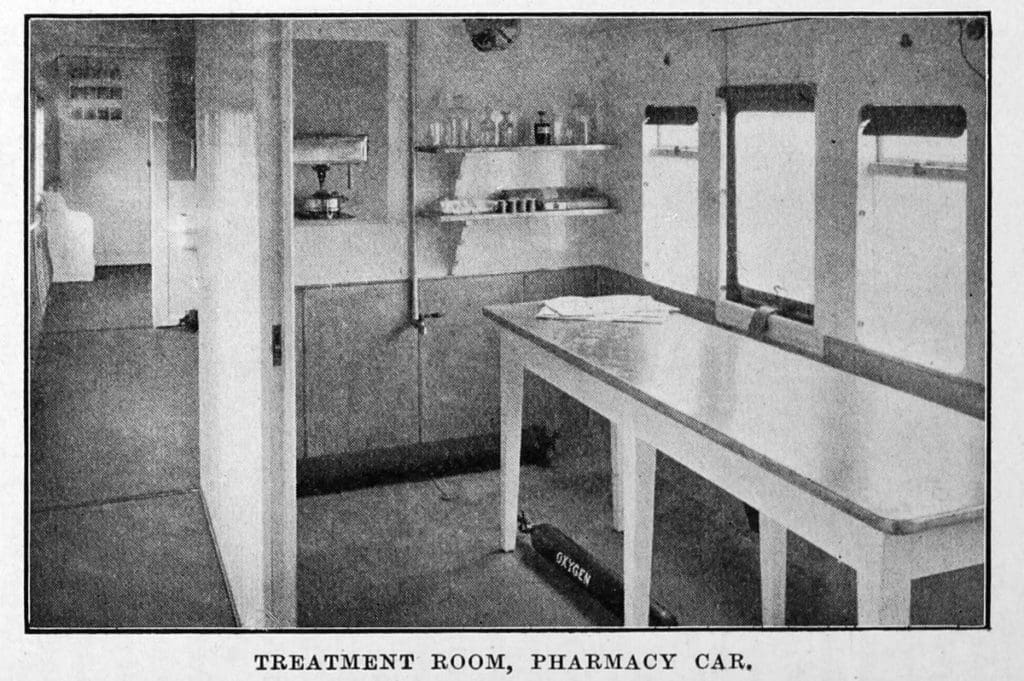

Explore The Railway Magazine archive for more articles like this one.


